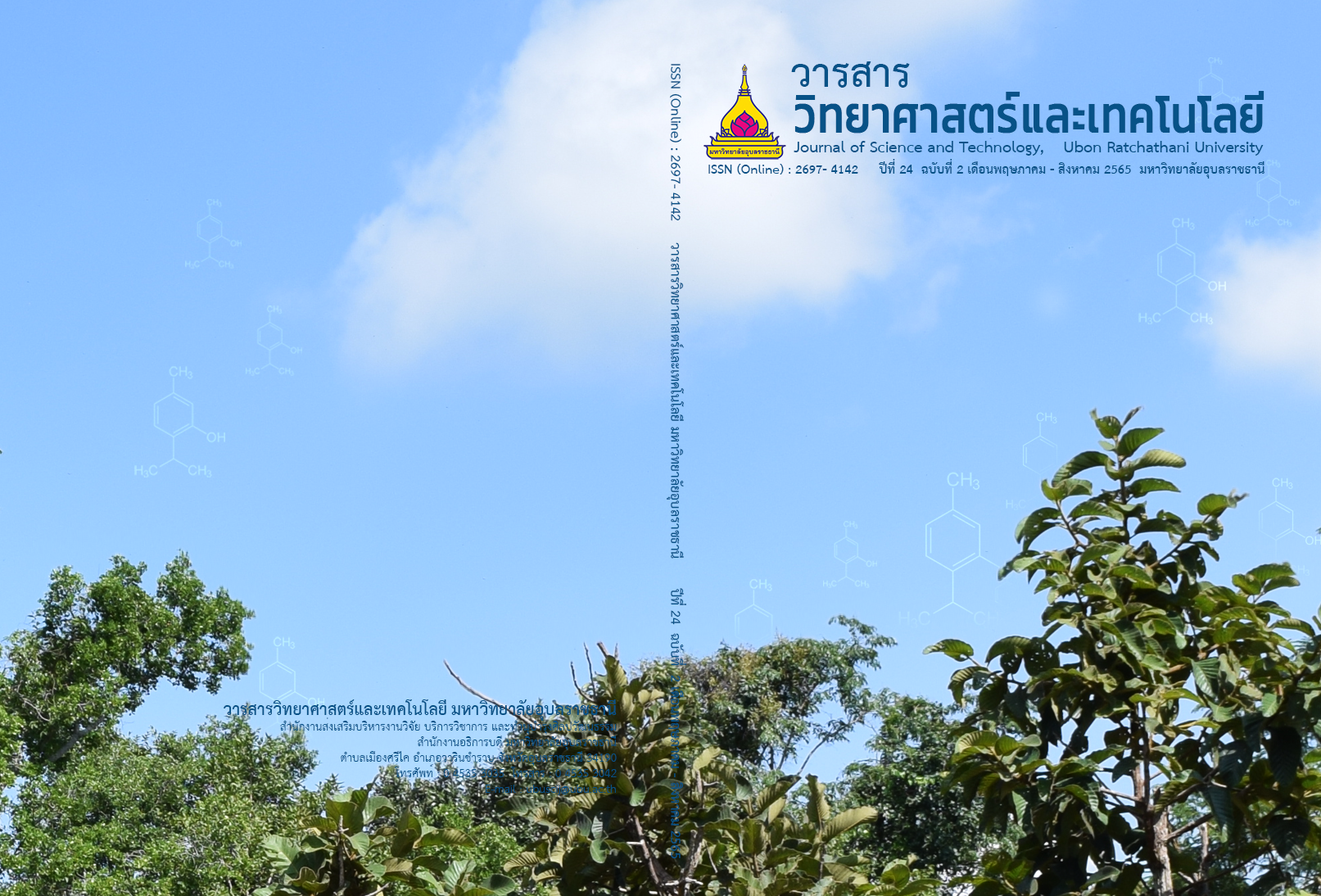อิทธิพลของปุ๋ยไนโตรเจนต่อองค์ประกอบผลผลิตและผลผลิตของข้าวหอมวาริน ที่ปลูกในดินที่มีความอุดมสมบูรณ์ต่ำ
Main Article Content
บทคัดย่อ
งานวิจัยนี้มีวัตถุประสงค์เพื่อศึกษาอิทธิพลของปุ๋ยไนโตรเจนต่อองค์ประกอบผลผลิต และผลผลิตของข้าวหอมวารินที่ปลูกในดินทรายร่วนที่มีความอุดมสมบูรณ์ต่ำ วางแผนการทดลองแบบ randomized complete block design (RCBD) จำนวน 3 ซ้ำ โดยมีตำรับทดลอง 5 ตำรับ ที่มีปุ๋ยไนโตรเจน (N) ในอัตรา 0, 4, 8, 12 และ 16 กิโลกรัมไนโตรเจนต่อไร่ ในแต่ละตำรับทดลองใส่ปุ๋ยฟอสฟอรัส (P2O5) และปุ๋ยโพแทสเซียม (K2O) ในอัตรา 8 กิโลกรัมฟอสฟอรัสต่อไร่ และ 12 กิโลกรัมโพแทสเซียมต่อไร่ ตามลำดับ ผลการศึกษา พบว่า การใส่ปุ๋ยไนโตรเจนในอัตราที่แตกต่างกันมีผลทำให้จำนวนหน่อต่อกอ จำนวนรวงต่อกอ และน้ำหนัก 1,000 เมล็ด ของข้าวหอมวาริน มีความแตกต่างอย่างมีนัยสำคัญทางสถิติ (P<0.05) แต่ไม่มีผลทำให้ความสูง เปอร์เซ็นต์การออกรวง น้ำหนักต้นสด และน้ำหนักต้นแห้ง เปอร์เซ็นต์เมล็ดดี เปอร์เซ็นต์เมล็ดลีบ และผลผลิต แตกต่างกันอย่างมีนัยสำคัญทางสถิติ อย่างไรก็ตามการใส่ปุ๋ยไนโตรเจนในอัตรา 8 กิโลกรัมไนโตรเจนต่อไร่ให้ผลผลิตสูงสุด (906.75 กิโลกรัมต่อไร่) นอกจากนี้ยังพบว่าผลผลิตข้าวหอมวารินมีสหสัมพันธ์เชิงบวกกับความสูง (r=0.919**) จำนวนหน่อต่อกอ (r=0.884**) จำนวนรวงต่อกอ (r=0.886**) น้ำหนักต้นสด (r=0.890**) และน้ำหนักต้นแห้ง (r=0.954**) การใส่ปุ๋ยไนโตรเจนในอัตราที่แตกต่างกันมีผลทำให้ดินหลังปลูกมีความเป็นกรดเป็นด่างของดิน (pH) แตกต่างกันอย่างมีนัยสำคัญทางสถิติ (P<0.05) แต่ไม่มีผลทำให้ปริมาณอินทรียวัตถุ ไนโตรเจน ฟอสฟอรัสที่เป็นประโยชน์ และโพแทสเซียมที่แลกเปลี่ยนได้ ในดินหลังปลูกแตกต่างกันอย่างมีนัยสำคัญทางสถิติ
Article Details

อนุญาตภายใต้เงื่อนไข Creative Commons Attribution-NonCommercial-NoDerivatives 4.0 International License.
บทความที่ได้รับการตีพิมพ์เป็นลิขสิทธิ์ของ วารสารวิทยาศาสตร์และเทคโนโลยี มหาวิทยาลัยอุบลราชธานี
ข้อความที่ปรากฏในบทความแต่ละเรื่องในวารสารวิชาการเล่มนี้เป็นความคิดเห็นส่วนตัวของผู้เขียนแต่ละท่านไม่เกี่ยวข้องกับมหาวิทยาลัยอุบลราชธานี และคณาจารย์ท่านอื่นๆในมหาวิทยาลัยฯ แต่อย่างใด ความรับผิดชอบองค์ประกอบทั้งหมดของบทความแต่ละเรื่องเป็นของผู้เขียนแต่ละท่าน หากมีความผิดพลาดใดๆ ผู้เขียนแต่ละท่านจะรับผิดชอบบทความของตนเองแต่ผู้เดียว
เอกสารอ้างอิง
Office of Agricultural Economics. 2019. Agricultural Production Data in-Season Rice: Cultivated Area Yield and Yield/Rai Province Species Crop Year 2019/2020. http://www.oae.go.th/ view/1/ตารางแสดงรายละเอียดข้าวนาปี/TH-TH. Accessed 5 September 2021. (in Thai)
Koohatammakun, N. and Saengsuwan, S. 2017. Urea controlled released fertilizers for agricultural applications. Journal of Science and Technology, Ubon Ratchathani University. 19(3): 32-44. (in Thai)
Poomipan, P. and et al. 2016. Comparison between chemical fertilizer and high quality organic fertilizer on quality of rice variety Suphan Buri 1. Journal of Science and Technology. 24(5) (Special): 753-765. (in Thai)
Zhang, Y. and et al. 2013. Synthesis and urea sustained-release behavior of an eco-friendly superabsorbent based on flax yarn wastes. Carbohydrate Polymers. 91: 277-283.
Liu, R., Kang, Y. and Zhang, C. 2014. Chemical fertilizer pollution control using drip fertigation for conservation of water quality in Danjiangkou Reservoir. Nutrient Cycling in Agroecosystems. 98: 295-307.
Katengam, S. and et al. 2011. Conversion of wide adapted rice cultivar IR57514 into Jasmine-like cooking quality through marker assisted backcrossing. In: Proceedings of the BIT's 2nd World DNA and Genome Day-2011, 25-29 April 2011. Dalian, China.
Namdang, N. and et al. 2020. The Influence of nitrogen fertilizer on yield components and yield of khao jao homwarin. In: Proceedings of the 14th UBU Research Conference, 3-4 September 2020. Ubon Ratchathani, Thailand. (in Thai)
Suksawat, M. 2001. Soil fertility. Bangkok: Odeonstore Press. (in Thai)
Land Development Department. 2017. Characteristics and Properties of Soil Series in the Northeast (Roi-et Series: Re). http://www.ldd.go.th/thaisoils_museum/pf_desc/northeast/Re.htm. Accessed 22 May 2019. (in Thai)
Department of Agriculture. 2000. Rice Knowledge Bank. Fertilizer Recommendations in Paddy and Winter Cereal Crops. http://www.rice thailand.go.th/Rkb/manual/index.php.htm. Accessed 13 May 2019. (in Thai)
Isuwan, A. 2016. The effects of site-specific fertilizer management on yield and fertilizer nitrogen use efficiency of Supanburi 1 rice grown on Wattana soil series. Khon Kaen Agriculture Journal. 44(3): 383-390. (in Thai)
Cheun-im, N. and et al. 2010. Application of chemical fertilizers on paddy field according to the soil analysis data. In: Proceedings of the 48th Kasetsart University Annual Conference: Plants, 3-5 February 2010. Bangkok, Thailand. (in Thai)
Isuwan, A. 2014. Site-specific fertilizer management on growth, yield, and agronomic nitrogen use efficiency of rice grown in Sapphaya soil series. Journal of Agriculture. 30(2): 133-140. (in Thai)
Nantachan, K. and et al. 2016. Effect of nitrogen fertilizer on grain yield and zinc concentration in local rice varieties. Khon Kaen Agriculture Journal. 44(3): 391-398. (in Thai)
Thongchon, P., Inthasan, J. and Konsaeng, S. 2016. The effect of silicon and nitrogen on growth and nutrient uptake of rice at tillering stage. Agricultural Science Journal. 47(2) (Suppl.): 409-412. (in Thai)
Khewaram, T. and Isuwan, A. 2018. Effects of fertilization regimes on yield and nutrient use efficiency of Pathum Thani 1 rice grown in Samut Prakan soil series. In: Proceedings of the 3rd National Conference (RTUNC 2018), 25 May 2018. Ubon Ratchathani, Thailand. (in Thai)
Sukyankij, S. and Pluemphuak, T. 2015. Effect of nitrogen site specific fertilizer on yield and primary nutrition in rice RD41 variety planted in Ayutthaya soil series. Agricultural Science Journal. 46(3)(Suppl.): 577-580. (in Thai)
Osotsapar, Y. 2000. Plant Nutrients. Bangkok: Kasetsart University Press. (in Thai)
Osotsapar, Y., Wongmaneeroj, A. and Hongproyoon, C. 2008. Fertilizers for Sustainability Agriculture. Bangkok: Kasetsart University Press. (in Thai)
Yoshida, S. 1972. Physiology aspects of grain yield. Annual Reviw of Plant Physiology. 23(1): 437-464.
Rice Research Institute. 2004. Recommendations for Using Fertilizers in Rice Fields According to Soil Analysis. http://library.ricethailand.go. th/images/stories/book/2562/pdf/122/brrdbook122.pdf. Accessed 12 September 2021. (in Thai)


